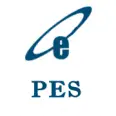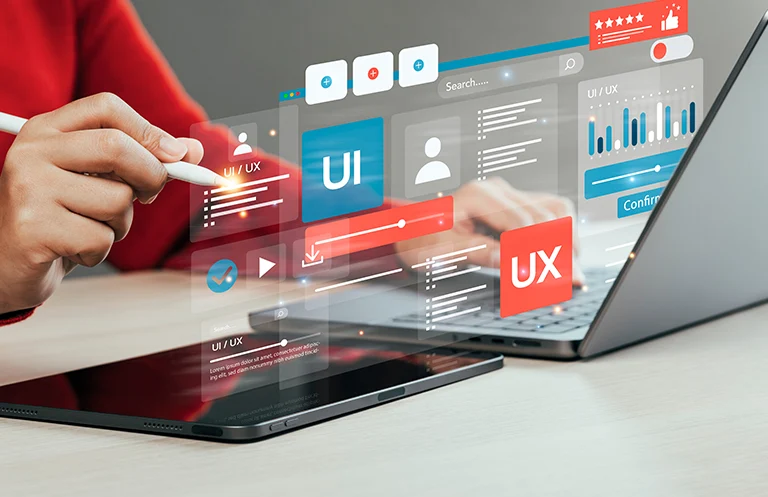It’s a deeply held belief among entrepreneurs as well as established industry leaders that early adopters of any new technology trend are more likely to succeed in that space later, as they have already worked hard to create innovative offerings that can disrupt, and dominate afterward.
We all may agree that timely investment in the right business technology, for example, Internet of Things (IoT), is a recipe for long-term growth and success. However, many companies are hesitant to explore new technologies, as they do not have the required experience. On the other hand, getting engineering teams onboard with new technology adoption requires work. As soon as the rubber hits the road, there will be a lot of uncertainty factors that can create challenges and slowdowns, discouraging even the most ardent, techno-enthusiast companies from making their mark in a given technology arena. It’s a path laid out with plenty of obstacles in terms of resources, cost, time and business priorities.
The trick to climbing a building is to move up one rung of the ladder at a time. Smart organizations realize that in order to switch their technology roadmap from wishlist to reality, they need to elevate their capabilities at a rapid pace. This includes gaining platform expertise in new tools and software, introducing accelerators and frameworks, getting proper guidance in terms of skills-sets evaluation and upgrades, studying commercial viability and long-term feasibility, taking “make or buy” decisions, evaluating the implementation and operational costs, and so on.
The Role of Product Engineering Services in Modern Technology Space
Thankfully, not having the right domain experience and technical expertise is not that great of a barrier anymore when it comes to building profitable products and leaving behind a legacy for years to come. So, instead of relying on homegrown talent and resources, which requires high investment in time and money, companies can still leverage the expertise of product engineering service (PES) providers like eInfochips, who are helping technology-intensive companies across various industries to hit the bull’s-eye each time when it comes to leveraging new technologies to build outstanding products.
HANDPICKED RELATED CONTENT:
A cursory glance at our success stories page would reveal the extraordinary lengths the right PES partner can go in helping clients find the right technological solution tailored according to their needs. All you need is an understanding, motivated, skilled and committed team of professionals to migrate your ideas from concept to reality.
Apart from leveraging the skillsets, many companies are looking for ideal partners who will help them to transform their legacy systems and help sustain their core business strengths. This is an important aspect for any company when it comes to working with a PES vendor.
What is PES? How Does It Help?
As buyers continue to insist on latest features and functionalities with quick turnaround time, businesses push for superior quality and cost benefits from product manufacturers. This has led to the creation of a completely new engineering service by vendors like eInfochips, which is dedicated to launching products faster into the market.
Product engineering service can be defined as an engineering consulting activity, which uses various hardware, embedded, software and IT services solution for the designing and development of products.
There are different phases of product engineering from inception to the end of the lifecycle of a product. Therefore, when we talk about product engineering, it is also important to know about different phases of product engineering. Let’s look at the different phases of product development:
Concept (conceiving the idea): This is the initial stage, which involves conceiving the idea and at the same time documenting it in terms of specifications and requirements. Then the idea is further scrutinized to know whether it is worth pursuing or not. Though a concept may seem exciting at the first glance, it may not always be worth pursuing.
Design: Once the concept is finalized, the next phase is to bring the concept to life by creating engineering designs. Any improvements and changes are also made in this phase before the design is finalized.
Development: The next phase is about developing or assembling of the product. A lot of attention is paid to implementing the project and managing and optimizing costs.
Testing: A developed product always has to go through stringent quality checks to validate that the developed product is fault-free and can be used as intended. Any faults need to be identified during this phase and then required changes, modifications or rectification is done in order to release the product.
Release: Once the product is developed, it is then released into the market. Feedback has to be collected from users to further improve the product in the following versions. It can also be given to external product testers to understand the user experience.
Continuous maintenance and support have to be provided until the product reaches the end of lifecycle and is replaced by another product or variant.
Sustenance/Re-engineering: Once the product is released into the market, periodic updates and enhancements will be pushed with time along with maintenance. A support system also needs to be established to meet customer grievances and to rectify those issues in a timely manner. Sustenance has to be provided for the intended lifespan of the product.
Re-engineering is an important part as well because products have to be designed in such a way that they can be scaled to meet customer demands in the future. This not only helps cater to the customer needs, but also allows the products to evolve.
According to Markets and Markets (Markets, 2016), the product engineering services market is estimated to reach USD 1,003.12 Billion by 2021, at a CAGR of 8.2% from 2016 to 2021. Consumer demand for outsourced product engineering services is growing at an unprecedented pace today because the aim of these services is to help customers focus on their core business processes. Such services also help customers avail substantial advantages gained through low-cost technological leadership.
According to Markets and Markets, #ProductEngineeringServices market is estimated to reach USD 1,003.12 Billion by 2021 @einfochipsltd
Outsourcing PES functions not only helps to reduce the service and manufacturing costs, but also help businesses become competitive in ways that could not be visualized before. With PES, companies can:
- Get the bandwidth to focus on their core competencies while leaving the rest to the PES division of the outsourced vendor
- Gain expertise in a new technology domain, which was hitherto not possible due to time and resource constraints
- Achieve system interoperability by working across a host of new third-party devices and platforms
- Become quick and agile when it comes to responding to real-time customer needs
- Transform their legacy services or products to survive amidst the competition. This is another important aspect where PES partners can play a vital role.
Engaging with a PES provider is a better way to develop products compared to collaborating with another company as your intellectual property (IP) remains safe due to the nature of such contracts.
If you are a company looking to outsource to PES solution providers, a vendor involved will perform typical procedures in giving you the maximum value for your investment and time.
Let us understand the standard steps followed by a PES vendor.
Stages of PES
Step 1: Identification of Pedigree
Assess where you stand in your ability to respond to customer expectations in a given technology space
“Look before you leap” is more than an adage when it comes to diversifying your company’s business interests into a new domain or working in your existing field. The story behind every failed launch can be traced back to previous failures to assess whether your existing resources have the underlying skills, domain knowledge, and technical depth to deliver end user value based on their needs and demands. At the end of the day, your “pedigree” matters.
Do you have a sufficient legacy in the technology area that you are embarking on? It doesn’t always mean that you have to be the first mover in a new space, although that does help to a great extent.
It could be an answer to a simple question on “whether you already have a sizeable marketshare of customers who would accept your new offerings as an extension of the value you provide them?” For instance, Apple insists on exceptional design capabilities at the core of its product development efforts in various areas. For Google, it would be a sophisticated grasp on algorithms and analytical capabilities for tons of data.
According to the consulting firm Bain & Company, the “litmus test” for a core competency should be that it is very hard for competitors to copy or develop.[1] Honestly answering the following questions will help any organization understand their pedigree for success:
- What do my customers know me for? (Begin with your mission and vision statements.)
- How much experience do I have?
- What is my brand recall value with respect to competitors?
- If I make forays into a new, unknown domain, will it be seen as something very distant to my business interests, or something that readily integrates with my existing business pedigree? Y/N
If the answer to the last question is negative, you will have to rethink your strategy with respect to the new business domains.
What’s the next step? Gap analysis vs. Stop-gap arrangements
Once you are clear about your business pedigree, it is important to do a proper gap analysis of your existing capabilities in product design and innovation. Identifying your true potential in a new business arena is not just a leap of faith. It is good to come with a quantification in terms of your resource, time and cost allocation in such a future pursuit.
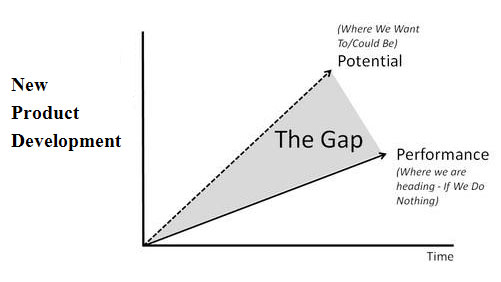
| Sample Questions to be asked | Outcome |
| Do I have the engineering bench strength required to support new product development? | |
| How ready am I in terms of percentage? | —% |
| How does the current market landscape look like for these products and offerings? Optimistic, Pessimistic or Uncertain | On a scale of 1 to 10 |
| Would I need outside expertise in slightly less core areas? | Y/N |
| Can I spell out 5-10 end-user benefits with at least 2 unique benefits? | Y/N |
Step 2: Prototyping and Ideation
Validate your product concept and convince partners and stakeholders
Development of innovative products requires cutting-edge technology skills, disciplined execution, and a shared responsibility towards the final goal. Ideation begins when you are able to clearly define the scope of the problem at the customer end and finish a proof-of-concept prototype. Spending more on this activity will ensure companies create a strong basis for the rest of the product development.
What features and functionalities should you include in a given prototype? What is more important to build and what should be omitted? These are difficult questions to answer at first, especially when you are embarking into a new technology space. This is where a PES vendor can help you achieve a concrete product concept.
PES companies help their clients realize their bold ideas and visions and convert them into working prototypes.
How ideation looks like with a PES vendor
Case Study: Surveillance Camera – Market Research, Benchmarking, and Go-to-Market Strategy
IDEATION: The client is a well-known value-added reseller with a sizeable presence in cameras, security equipment, and telecommunications. In order to ride the next wave of growth in IP camera market, the client was evaluating the prospect of vertical integration into surveillance camera technologies. Since this would be a path-breaking business decision, the client wanted to weigh scope and profitability against potential business risks. For that reason, they were looking for a solutions partner with an in-depth understanding of the market along with expertise in end-to-end product development.
OUTCOME: The client approached eInfochips for market analysis and strategic consulting based on its extensive experience in the IP camera domain. eInfochips performed detailed secondary research in collaboration with a market research firm. This involved studying a total of 400 camera variants, covering all industry leaders, with an aim to identify and finalize custom market sub-segments. A detailed analysis of the client’s motivation and risk appetite was made, followed by submission of a research report, which aided in making the decision on whether or not to venture into the camera surveillance market. eInfochips also helped the client categorize end-user segments to create product, branding and market positioning strategies, hence, laying the foundation for phase zero of the project.
Step 3: Finding Your Engagement Model with PES vendor
ODC, dedicated teams, time and resource utilization
The PES vendor should be capable of providing a broad variety of engagement models to suit the client’s time and resource constraints. Here is a sample selection of engagement models used by eInfochips. Selecting the right engagement model may be critical to the success of your business since it will not only accelerate your launch cycle, but also contribute enormously to providing long-term value to the clients. The standard engagement models are given below from which a customer can choose the best in accordance with the project requirements.
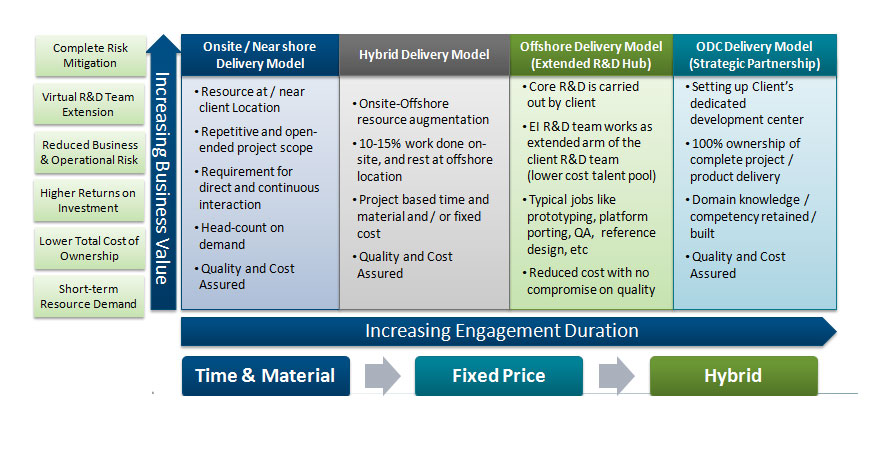
Selecting the right engagement model—Time and Material, #Onsite, #Offshore, Fixed Cost and Hybrid is critical to the success of product in #PES @einfochipsltd
Step 4: The Role of Accelerators and Incubators
Accelerators/incubators are becoming popular with global enterprises struggling to ship new products and create innovative business ecosystems on their own. Small companies interested in creating a physical product require hardware and product accelerators to help them succeed in the business.
What is an accelerator? What is an incubator? Differences.
The best way to determine if a program is an accelerator or an incubator is to find out if there’s a scheduled end date for the entire program. If the program ends after 3-4 months, it’s an accelerator, but if the program does not have an end date and offers to mentor, it is an incubator/innovation lab.
Step 5: End-to-End PES Services like DevOps etc.
Grand View Research forecasts that the concept of DevOps is expanding. It is not just a QA concept, but is now a centerpiece of enterprise growth strategy. It is being adopted widely: the DevOps market size in 2018 was USD 2.77 billion and it is expected to grow by CAGR 18.6 to reach USD 12.5 billion by 2025. What is fueling DevOps adoption? “Increasing digitization of enterprises to automate business processes, rising adoption of cloud technologies, soaring adoption of agile frameworks, and need for better collaboration between IT teams to enhance operational efficiency.” Technology trends like the Internet of Things and cloud computing are playing a key role in the sustained growth of DevOps.
eInfochips has extensive experience in product engineering and leverages this expertise to provide customers with comprehensive DevOps/CloudOps services spanning DevOps/CloudOps consulting, DevOps end-to-end implementation, tools evaluation and infrastructure monitoring (application, network, cloud and device.) Leveraging the DevOps Assessment Framework, eInfochips delivers strategies and solutions that help clients maximize the benefits of their DevOps investment.
HANDPICKED RELATED CONTENT:
Step 6: Support and Maintenance Services
Support and maintenance in PES should not be just a cash cow stage for the PES vendor. It should be a source of competitive advantage for the growth through superior customer connect and synthesis of data to discover new customer needs. It should be a space to identify insights to improve the product.

The main objectives of Product Sustenance Engineering are as follows:
- Maintain/Increase customer loyalty
- Meet functional and non-functional needs
- Install/configure, use, integrate, upgrade & replace
- Analyze and fix defects for unperturbed use
- Redirect focus and resources from existing to the new products
- Increase ROI
- Reduce cost
- Optimize investment in enhancements of existing products
- Improve productivity / operational efficiency with a high degree of automation in processes, testing and elsewhere
- Focus more on core competencies
- Gain customer insight
- Extend the life of the product
- Improve next-generation product definition
- Manage resources effectively
- Deliver competitive advantage
- Transform sustenance through DevOps
- Drive Business Intelligence for customer insights
- Customize delivery and financially engineered commercial models
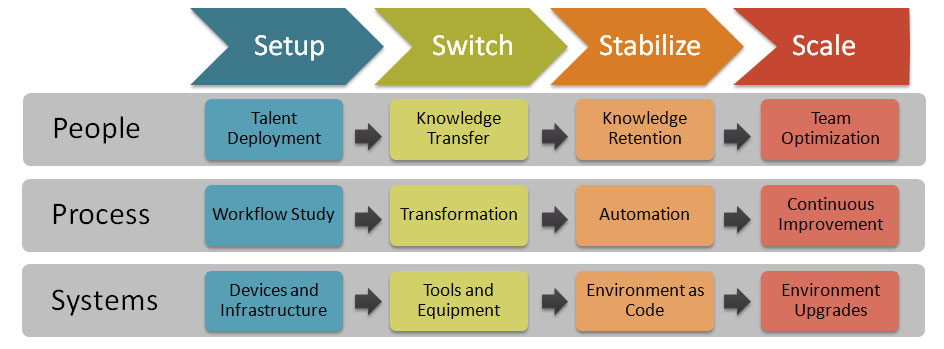
eInfochips works as a strategic partner for product and solutions companies around the world. We help Startups & Enterprises achieve faster time-to-market and optimize cost with innovative products and solutions. We help you think beyond transaction-driven growth strategies and start creating real value. Schedule a call with our experts to know more about our product engineering services.

